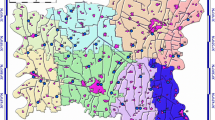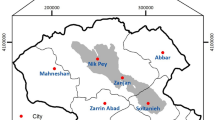Abstract
A systematic monitoring program was implemented in 1999 to evaluate the temporal changes in the physical properties and chemical composition of water from the Shahrood Qanat, which provides 30% of Shahrood’s municipal water needs. A qanat is a near-horizontal gallery which yields water by gravity. The results show that the physical properties, in contrast to the concentration of ions, are in an almost “steady state” condition and the slight variations are due to the travel time of water in the qanat gallery, the mixing of qanat water, the seasonal temperature fluctuation, and the likely unavoidable errors associated with long-term monitoring. They also show that severe drought during the past nine years has not yet affected the groundwater quality. The TDS of the qanat water is relatively low and the water is of the calcium-bicarbonate type. However, the above average concentrations of nitrate (14.9 mg/L) and phosphate (0.105 mg/L) may reflect the impact of the excessive use of fertilizers in the capture zone of the qanat. High Ca, Mg, pH, and a higher-than-recommended hardness value reflect the influence of carbonate-rock formations on the groundwater composition. The study shows that systematic monitoring is required to identify the erroneous data, to optimize the monitoring program and to characterize the water quality trend.
Résumé
A partir de 1999 on a mis au point un programme de surveillance systématique pour évaluer les changements temporelle des propriétés physiques et chimiques de l’eau du captage de type qanat de Shahrood. Il a résulté que les propriétés physiques sont presque stationnaires, les variations insignifiants ayant dues au temps de transfert et au mélange de l’eau dans la galerie, aux variations saisonnières de la température ainsi qu’aux erreurs inévitables associées à une surveillance à long terme. Cet étude a montré aussi que la qualité de l’eau n’a pas été influencée par la période de neuf ans de sécheresse. Le résidu à sec de l’eau présente des variations assez faibles et l’eau appartient à la catégorie de Calcium-Bicarbonate. Tout de même les valeurs moyennes des concentrations en nitrates (14.5 mg/L) et en phosphates (0.105 mg/L) mettent en évidence l’impact de l’utilisation excessive des engrains dans les zones de captage de qanat de Shahrood. Les valeurs élevées de la concentrations en Ca et Mg, du pH et le fait que la dureté dépasse les limites recommandées mettent en évidence l’influence des carbonates de la matrice sur la composition des eaux souterraines. Cet étude montre aussi qu’il est nécessaire une surveillance systématique affin d’identifier les données erronées, d’optimiser le programme de monitoring et d’estimer les changements potentielles de la qualité de l’eau.
Resumen
En 1999 fue implementado un programa intensivo y sistemático de monitoreo, para evaluar los cambios temporales en las propiedades físicas y en la composición química de la galería para captar agua tipo kanat de Shahrood. Los resultados muestran que las propiedades físicas se encuentran casi en una “condición estacionaria” y que las poco significativas y tenues variaciones, se deben al tiempo de viaje del agua en la galería kanat, a la mezcla del agua del kanat, a la fluctuación estacional de temperaturas y a los probables e inevitables errores asociados con el monitoreo de largo plazo. Con base en los resultados del presente estudio se determinó que las sequías más severas, ocurridas durante los últimos nueve años, no han afectado aún la calidad del agua subterránea. El contenido de TDS en el agua del kanat es relativamente bajo y el agua es del tipo bicarbonatada-calcica. Sin embargo las concentraciones por encima del promedio de nitratos (14.5 mg/L) y fosfatos (0.105 mg/L), reflejan el impacto del uso excesivo de fertilizantes en la zona de captura del kanat, sobre la calidad del agua subterránea. Los valores altos de Ca, Mg, pH y dureza reflejan la influencia de las formaciones carbonatadas sobre la composición del agua subterránea. El estudio muestra que se necesita un monitoreo sistemático para identificar los datos erróneos, lo mismo que para optimizar el programa de monitoreo y para predecir potenciales cambios futuros en la calidad del agua.








Similar content being viewed by others
References
Bakhshi M (1998) A short report on the climate and water resources of Shahrood [in Persian]. In: Proc. of Shahrood and development symposium, November 1998, Shahrood, Iran, pp 143–164
Behnia A (1988) Construction and maintenance of qanats [in Persian]. Shahid Chamran University Press, Ahwaz, IRAN
Bell FG (1998) Environmenatl geology: principles and practice. Blackwell, London
Berenji A (1998) Evaluation of agricultural development in the Shahrood District [in Persian]. In: Proc. of Shahrood and development symposium, November 1998, Shahrood, Iran, pp 25–39
Chapman D (1996) Water quality assesments. University Press, Cambridge
Dewhurst RE, Mather JD, Callaghan A, Connon R, Crane M (2001) Assessing urban groundwater quality using biological and chemical methods. In Seiler KP, Wohnlich S (ed) Proc. of 31st IAH congress on new approaches characterizing groundwater flow. Swets and Zeitlinger, Lisse, pp 37–41
European Community (1980) Official gazette No. L229/11–229/29, European Communities, Luxembourg
Fetter CW (2001) Applied hydrogeology, 4th edn. Prentice Hall, Englewood Cliffs, New Jersey
Freeze RA, Cherry JA (1979) Groundwater, Prentice Hall, New Jersey
Fritz SJ (1994) A survey of charge-balance errors on published analyses of potable ground and surface waters. Groundwater 32:539–546
Hallberg GR (1989) Nitrates in the groundwater in the United States of America. In: Follett RF (ed) Nitrogen management and groundwater protection: developments in agriculture and managed-forest ecology, vol 21. Elsevier, Dordrecht
Hosseinipour EZ, Ghobadian A (1998) Sustainability of water resources in arid-central Iran. In: Brahana UV, Eckstein Y, Ongley LK, Schneider R, Moore JE (eds.) Proc. of international congress on ‘Gambling with groundwater: physical, chemical, and biological aspects of aquifer-stream relations’, September 1988, Las Vegas, Nevada, pp 401–406
Hounslow AW (1995) Water quality data: analysis and interpretation, CRC, Boca Raton, Florida
Kazemi GA (2003) Quality and vulnerability of groundwater in the Shahrood District, northeast Iran. In: Krasny K, Hrkal Z, Bruthan J (eds) Proc. of international conference on groundwater in fractured rocks, September 2003, Prague, IHP-VI series on groundwater no. 7, pp 209–210
Kazemi GA, Mehdizadeh H (2001) Solute content and chemical composition of atmospheric precipitation at Shahrood Region [in Persian]. In: Proc. of 5th Iranian geological convention, September 2001, pp 401–405
Kazemi GA, Mehdizadeh (2003) Trend, characteristics and chemical composition of atmospheric precipitation at Shahrood, Northeast Iran. In: Abstracts of the 33rd general assembly of the International Union of Geodesy and Geophysics (IUGG), July 2003, Sapporo, Japan
Kazemi G A, Mehdizadeh H, Ashoori R (2002) Evaluation of artificial recharge schemes in the Shahrood region, Iran. In: Dillon P (ed) Management of aquifer recharge for sustainability. Balkema, Lisse, pp 225–229
Kazemi GA, Fardoost F, Karami GH (2001) Hydrogeology and groundwater quality of Shahrood region, Iran. In: Seiler KP, Wohnlich S (eds) Proc. of 31st IAH congress on new approaches characterizing groundwater flow. Swets and Zeitlinger, Lisse, pp 1213–1216
Khazaei E (2002) The effect of urbanisation on the groundwater quality in Zahedan [in Persian]. Water and Wastewater 37:31–37
Kuhanesan S, Scriven DC, Huxley WJ, Keating BA, Verburg K (1998) Modelling nitrate movement in the Gooburrum Aquifer Complex, Bundaberg, Queensland. In: Weaver TR, Lawrence CR (eds) Proc. of International groundwater conference, New Generation, Victoria, pp 491–496
Lashkaripour GH, Ghafouri M (2002) Evaluation of nitrate concentration of groundwater in Mashad [in Persian]. Water and Wastewater 41:2–7
Mehdinia M, Nikravesh SH (2002) Evaluation of nitrate contamination of Damghan domestic water in Spring 2002 [in Persian]. Water and Wastewater 43:60–61
Moqadas H (2003) Quality of Shahrood municipal water. Unpublished BSc Thesis, Department of Geology, Shahrood University of Technology, Shahrood
Papoli Yazdi MH, Labaf R, Labaf M, Jalali A, Vosooqi F (2000) The Qassabeh Qanat of Gonabad: an icon [in Persian]. Khorasan Province Water Board, Khorasan, Iran
Price M (2002) Introducing groundwater, 2nd edn. Thornes, Cheltenham, UK
Rail CD (2000) Groundwater contamination: Contamination, sources and hydrology, vol 1. Technomics, Lancaster, Pennysylvania
Spalding RF, Exner ME (1993) Occurrence of nitrate in groundwater: a review. J Environ Qual 22:392–402
Steinich B, Escolero O, Marin LE (1998) Salt-water intrusion and nitrate contamination in the Valley of Hermosillo and El Sahuaral coastal aquifers, Sonora, Mexico. Hydrogeol J 6:518–526
Todd DK (1980) Groundwater Hydrology, 2nd edn. Wiley, New York
World Health Organisation (1993) Guidelines for drinking water quality, vol 1, 2nd edn. WHO, Geneva
Acknowledgements
Thanks are due to Dr. A. Taheri from the Geology Department, Shahrood University of Technology for his help in drafting the geologic map and qanat figure. Ms. F. Saedi from Chemistry Laboratory (SIRO) is thanked for performing water analysis. Thanks are also due to Mr. P. Komaili from the Water and Sewer Department (WSD) of Shahrood for his valuable information. The comments and review by Drs. E. Z. Hosseinipour from the West Coast Regional Water Supply Authority, Florida, USA and W. A. Milne-Home from the National Centre for Groundwater Management, University of Technology, Sydney have substantially improved this manuscript. Furthermore, this article has greatly benefited from the comments of an anonymous reviewer as well as an associate editor of the Hydrogeology Journal.
Author information
Authors and Affiliations
Corresponding author
Rights and permissions
About this article
Cite this article
Kazemi, G.A. Temporal changes in the physical properties and chemical composition of the municipal water supply of Shahrood, northeastern Iran. Hydrogeology Journal 12, 723–734 (2004). https://doi.org/10.1007/s10040-004-0370-0
Received:
Accepted:
Published:
Issue Date:
DOI: https://doi.org/10.1007/s10040-004-0370-0




